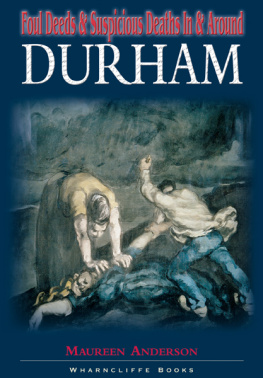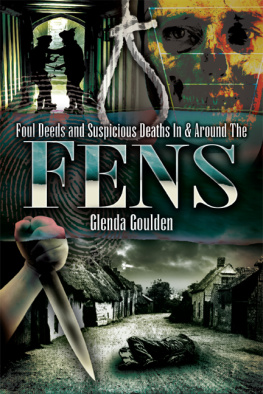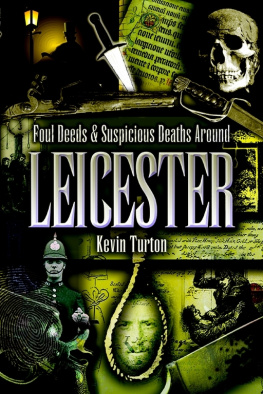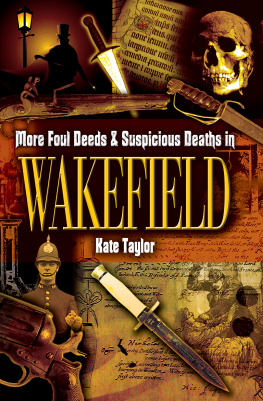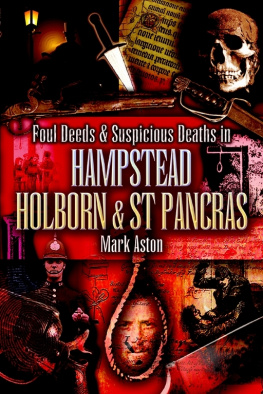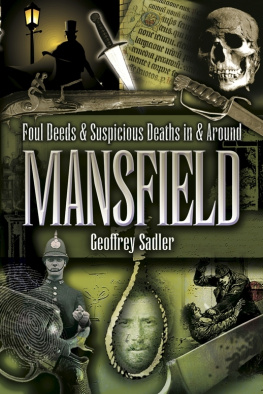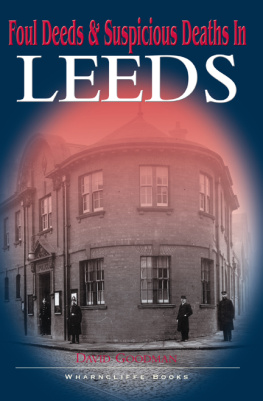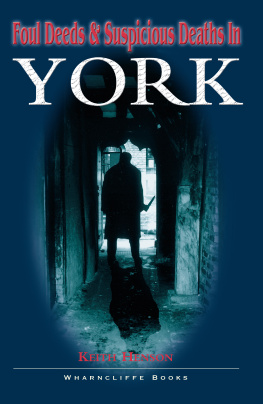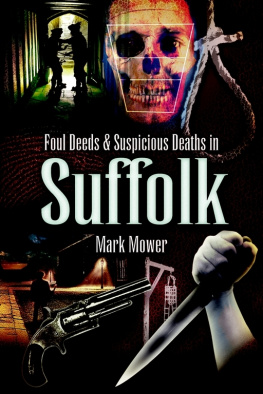FOUL DEEDS AND SUSPICIOUS DEATHS Series
Foul Deeds and Suspicious Deaths series explores in detail crimes of passion, brutal murders,
grisly deeds and foul misdemeanours. From Victorian street crime, to more modern murder
where passion, jealousy, or social depravation brought unexpected violence to those
involved. From mysterious death to murder and manslaughter, the books are a fascinating
insight into not only those whose lives are forever captured by the suffering they endured,
but also into the society that moulded and shaped their lives. Each book takes you on a
journey into the darker and unknown side of the area.
Other titles in the series
Foul Deeds and Suspicious Deaths in Blackburn & Hyndburn, Stephen Greenhalgh
1 903425 18 2 9.99
Foul Deeds & Suspicious Deaths In and Around Chesterfield, Geoffrey Sadler
1 903425 30 1 9.99
Foul Deeds and Suspicious Deaths In Leeds, David Goodman
1 903425 08 5 9.99
Foul Deeds and Suspicious Deaths in Nottingham, Kevin Turton
1 903425 35 2 9.99
Foul Deeds & Suspicious Deaths In and Around Rotherham, Kevin Turton
1 903425 27 1 9.99
Foul Deeds & Suspicious Deaths In and Around The Tees, Maureen Anderson
1 903425 26 3 9.99
Foul Deeds & Suspicious Deaths in Wakefield, Kate Taylor
1 903425 07 7 9.99
More Foul Deeds and Suspicious Deaths in Wakefield, Kate Taylor
1 903425 48 4, 9.99
Foul Deeds & Suspicious Deaths in York, Keith Henson
1 903425 33 6 9.99
Foul Deeds & Suspicious Deaths on the Yorkshire Coast,Alan Whitworth
1 903425 01 8 9.99
Other Local Books in the North East
Aspects of Hull, David Goodman
1 871647 62 2 9.95
Aspects of Teesside, Maureen Anderson
1 903425 19 0 9.99
Hull Pals, David Bilton
0 85052 634 5 18.95
Middlesbroughs Albert Park, Norman Moorsom
1 903425 22 0 9.99
Please contact us via any of the methods below for more information or a catalogue.
W H A R N C L I F F E B O O K S
47 Church Street Barnsley South Yorkshire S70 2AS
Tel: 01226 734555 734222 Fax: 01226 734438
E-mail:

First Published in 2003 by
Wharncliffe Books
an imprint of
Pen and Sword Books Limited,
47 Church Street, Barnsley,
South Yorkshire. S70 2AS
Copyright Maureen Anderson 2003
For up-to-date information on other titles produced under the
Wharncliffe imprint, please telephone or write to:
Wharncliffe Books
FREEPOST
47 Church Street
Barnsley
South Yorkshire S70 2BR
Telephone (24 hours): 01226 734555
ISBN: 1-903425-46-8
PRINT ISBN: 9781903425466
PDF ISBN: 9781783037810
EPUB ISBN: 9781783037834
PRC ISBN: 9781783037827
All rights reserved. No part of this publication may be
reproduced, stored in a retrieval system, or transmitted, in
any form or by any means, electronic, mechanical,
photocopying, recording or otherwise, without the prior
permission in writing of the publishers.
This book is sold subject to the condition that it shall not,
by way of trade or otherwise, be lent, resold, hired out or
otherwise circulated without the publishers prior consent in
any form of binding or cover other than that in which it is
published and without a similar condition including this
condition being imposed on the subsequent purchaser.
A CIP catalogue record of this book is available from the
British Library
Cover illustration:FrontLa Meurte (The Murder) by Paul Cezanne, 1868. Liverpool Walker Art Gallery
RearThe altar tomb of the Brass children, Kirk Merrington. The author
Printed in the United Kingdom by
CPI UK
Contents
Chapter 11 An Incestuous Relationship, 1860
Chapter 22 Manslaughter at South Church, 1878
Introduction
Durham Land of the Prince Bishops holds a unique place in the annals of history relating to counties within England. From the middle ages the county was in the hands of the Bishops of Durham. They ruled over both the religious and state affairs within their borders. The diocese was very wealthy, owning valuable land and mineral rights. The mid-nineteenth century saw the dismantling of the Palatinate and many of the countys assets were distributed throughout the Church of England and the diocese split.
In 1974 drastic boundary changes were implemented on County Durham. Sunderland, Gateshead and towns on the south bank of the Tyne became part of the new county of Tyne and Wear and the county of Cleveland was formed. The events in this book took place in some of the towns and villages that were part of Durham before the boundary changes.
It is probable that the Romans excavated for coal in Durham. The earliest record of coal mining here was recorded in the eleventh century in the Boldon Book when a miner supplied coal from Escomb to Coundon. By the early nineteenth century coal mines had sprung up all over Durham and families from the southern parts of England and from Ireland had arrived in their thousands seeking work. Records show there were 154,000 employed in the collieries within the area. Small existing villages and towns expanded to become host to the mineworkers and their families and new villages and towns were born. Many of these families had lived in abject poverty prior to the coal-mining boom. Now they found themselves with a little money, but sadly, instead of providing a better way of life for themselves, some of them spent their wages on alcohol. Along with the drink came domestic violence, cruelty and drunken brawls, often resulting in death. Women and children were not held in high esteem. Often the partner or spouse, sometimes because of suspected infidelity, whether real or imagined, became the victim of drunken rage. Throughout the nineteenth and twentieth centuries there were ninety-three recorded hangings in Durham. A large proportion of these were for the murder of a partner. Many of the murders related in these chapters resulted in the ultimate penalty of hanging.
Prior to the mid-nineteenth century, executions were carried out for almost any offence, including rape, the stealing of livestock or robbery. As a warning to others the body of a murderer would sometimes be hung in chains and left on display at or near to where the crime took place. Some of the executions were carried out with almost as much cruelty as the criminal had inflicted on the victim.
Although still far from perfect, the justice system has changed radically over the centuries. Once controlled largely by ignorance and superstition, the execution of a witch could be carried out with the finger of guilt pointed at someone because of the failure of crops, livestock becoming ill or even hens not laying. Conviction for a crime often relied on the statements of witnesses as to the suspects movements prior to and after the deed was committed. Gradually, forensic evidence has become more of an exact science helping to protect the innocent and convict the guilty.
Readers are left to make up their own minds as to whether justice was properly served in the sentences passed down in these events. Or, indeed, whether the person charged was really the guilty party.
Finding out how our ancestors lived and the genealogy of our families has become increasingly popular in recent years. Perhaps you have traced your family line to a certain point and been able to go no further? Well, it could be possible that the trail may have ended because your ancestor was a victim, or even perhaps the perpetrator of a crime who was hanged, imprisoned or transported by way of punishment.
Next page
